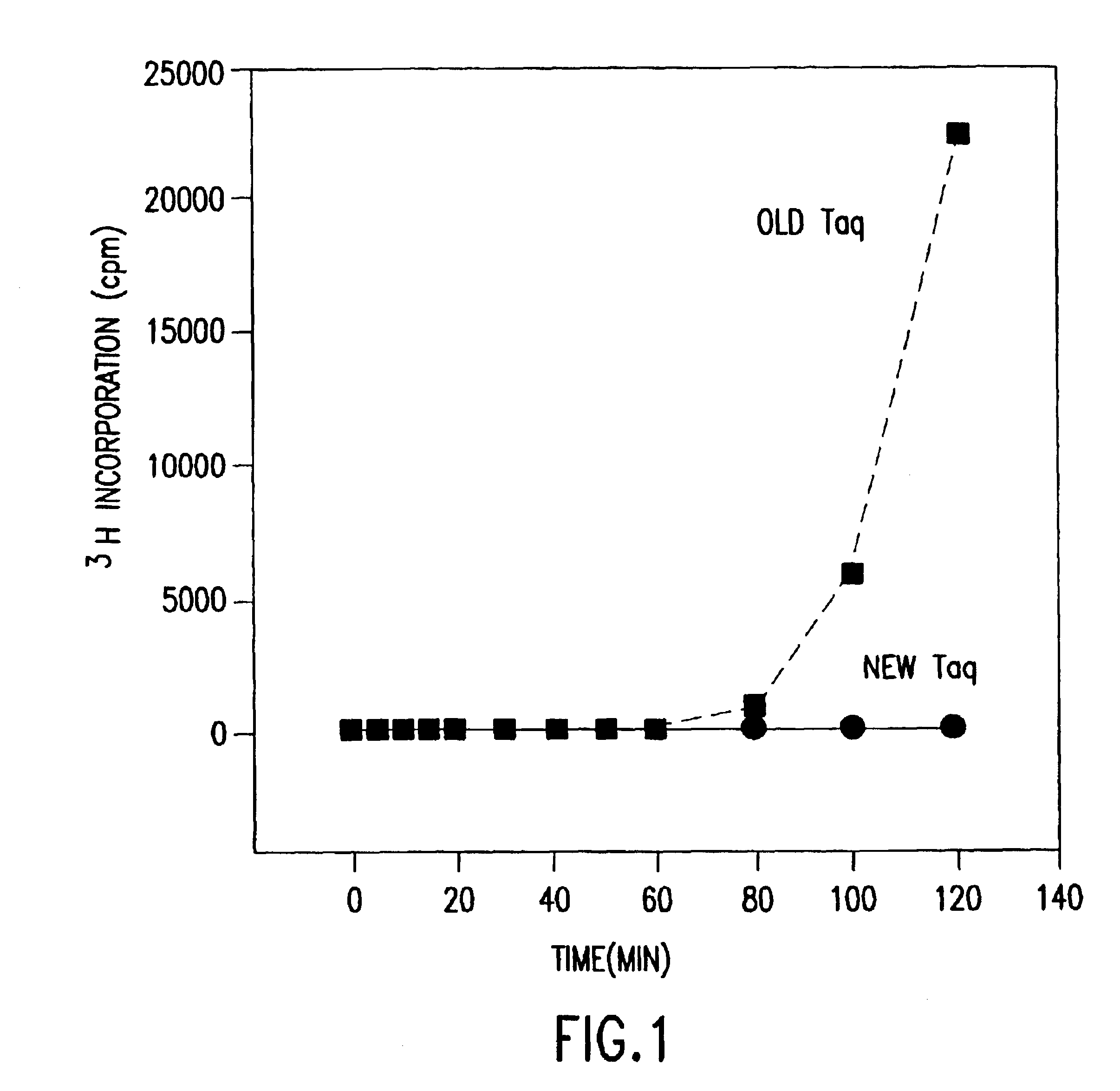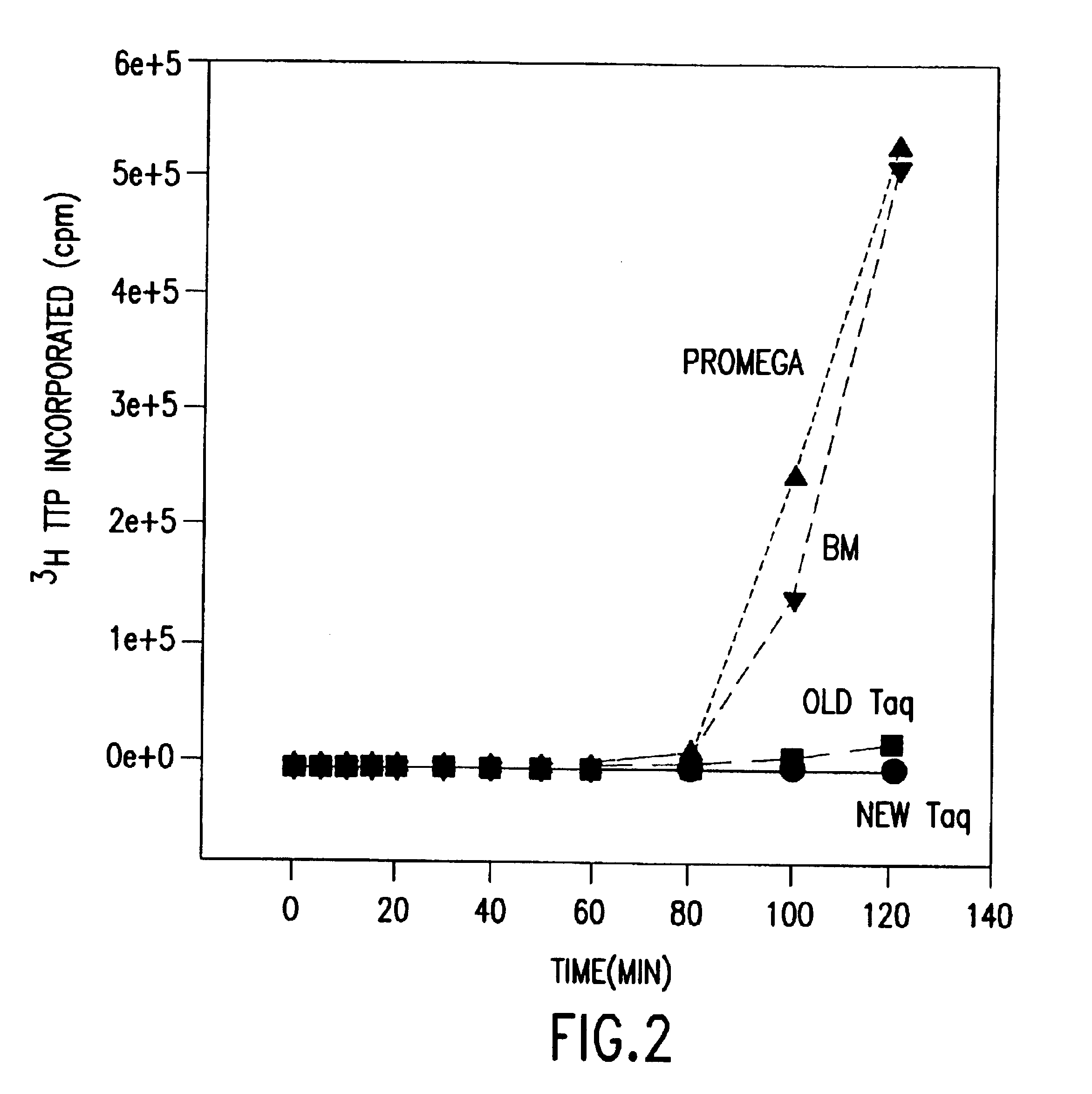Nucleic acid-free thermostable enzymes and methods of production thereof
a technology of thermostable enzymes and nucleic acid-free, which is applied in the field ofmolecular biology and protein chemistry, can solve the problems of large production-scale preparations, large batch sizes, and distinct disadvantages of methods
- Summary
- Abstract
- Description
- Claims
- Application Information
AI Technical Summary
Benefits of technology
Problems solved by technology
Method used
Image
Examples
example 1
Permeabilization of Bacterial Cells
[0036]In the initial steps of the purification process, bacterial cells (Thermus aquaticus, strain YT-1), which were obtained directly from actively growing cultures, or which were stored at −20° C. and partially thawed, were suspended at 500 g of cells / L into cold (4° C.,) of permeabilization buffer (100 mM TRIS, 1.8% TRITON X-100, 600 mM guanidine HCl, 1.5 mM EDTA, 1 mM dithiothreitol (DTT), pH 8.5). During suspension of the cells in the buffer, phenylmethylsulfonylfluoride (PMSF) was added to a final concentration of 0.5 mM. Cells were stirred for about 45 minutes at 4° C. to ensure complete suspension, and then ammonium sulfate was added to a final concentration of 200 mM and the cell suspension was stirred for an additional 45 minutes. During this time, cells were permeabilized via the action of the guanidine HCl and TRITON X-100, and intracellular protein release into the buffer was enhanced by the action of the ammonium sulfate.
example 2
Microfiltration, Concentration and Diafilitration of Extracts
[0037]Following permeabilization, one volume of filtration buffer (100 mM TRIS, 200 mM ammonium sulfate, 1 mM EDTA, 1 mM DTT, pH 8.9) was added to the cell suspension, and the suspension mixed completely. Microfiltration of the suspension was then carried out through a 0.2 μm Microgon mixed ester cellulose hollow fiber system, using a recirculation rate of 90 L / min. The suspension was diafiltered with six volumes of cold filtration buffer, collecting the permeate in a suitable sized chilled (4° C.) container. Under these conditions, thermostable enzymes passed through the membrane with the permeate, leaving the bacterial cells with most of the DNA in the retentate.
[0038]As the ultrafiltration proceeded, concentration of the permeate was begun once a sufficient volume had been collected to prime the second ultrafiltration system. Permeate was concentrated using an Amicon DC-90 system, through Microgon 10,000 MWCO membrane (...
example 3
Purification and Characterization of DNA-free Taq DNA Polymerase
[0039]Purification of enzyme from ultrafiltrate was accomplished by a series of chromatographic steps, using a procedure modified slightly from that described for purification of T5 DNA polymerase from E. coli (Hughes, A. J., Jr., et al., J. Cell. Biochem. Suppl. 0 16(Part B):84 (1992)).
[0040]A. Fractogel SO3
[0041]In the first chromatographic step, ultrafiltrate was passed over a Fractogel EMD SO3−-650(M) column (EM Separation Technologies, which removes most of the Taq I restriction enzyme and crude proteins from the ultrafiltrate. Ultrafiltrate was passed through a polypropylene depth filter to remove any residual precipitation, and loaded onto the Fractogel column at a flow rate of about 30 cm / hr. The column was then washed with 10 volumes of diafiltration buffer, and a 20 volume gradient from diafiltration buffer to SO3 elution buffer (25 mM bicine, 500 mM KCl, 1 mM EDTA, 1 mM DTT, pH 8.9) run at a flow rate of abo...
PUM
| Property | Measurement | Unit |
|---|---|---|
| wet weight | aaaaa | aaaaa |
| wet weight | aaaaa | aaaaa |
| wet weight | aaaaa | aaaaa |
Abstract
Description
Claims
Application Information
 Login to View More
Login to View More - R&D
- Intellectual Property
- Life Sciences
- Materials
- Tech Scout
- Unparalleled Data Quality
- Higher Quality Content
- 60% Fewer Hallucinations
Browse by: Latest US Patents, China's latest patents, Technical Efficacy Thesaurus, Application Domain, Technology Topic, Popular Technical Reports.
© 2025 PatSnap. All rights reserved.Legal|Privacy policy|Modern Slavery Act Transparency Statement|Sitemap|About US| Contact US: help@patsnap.com


